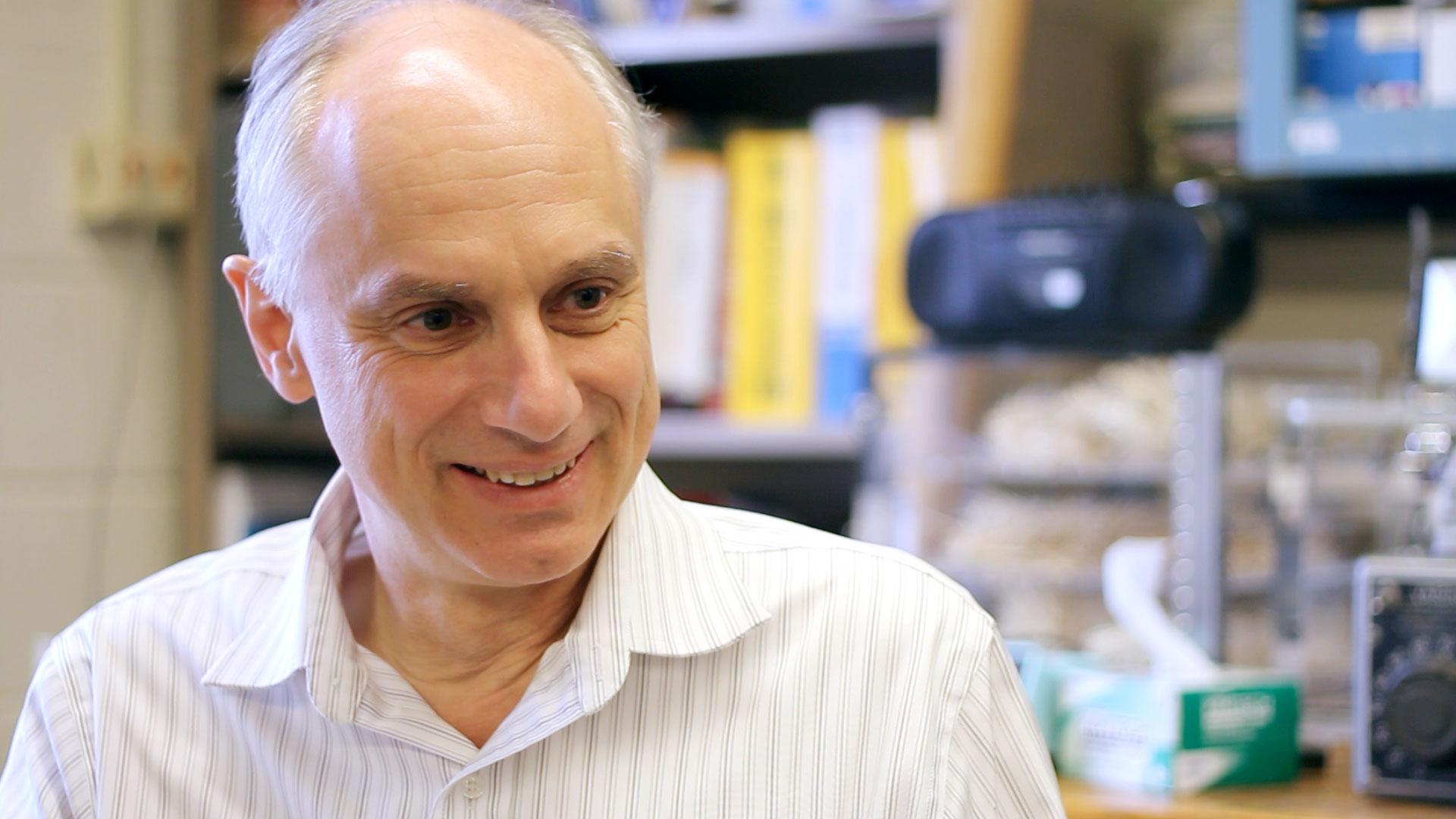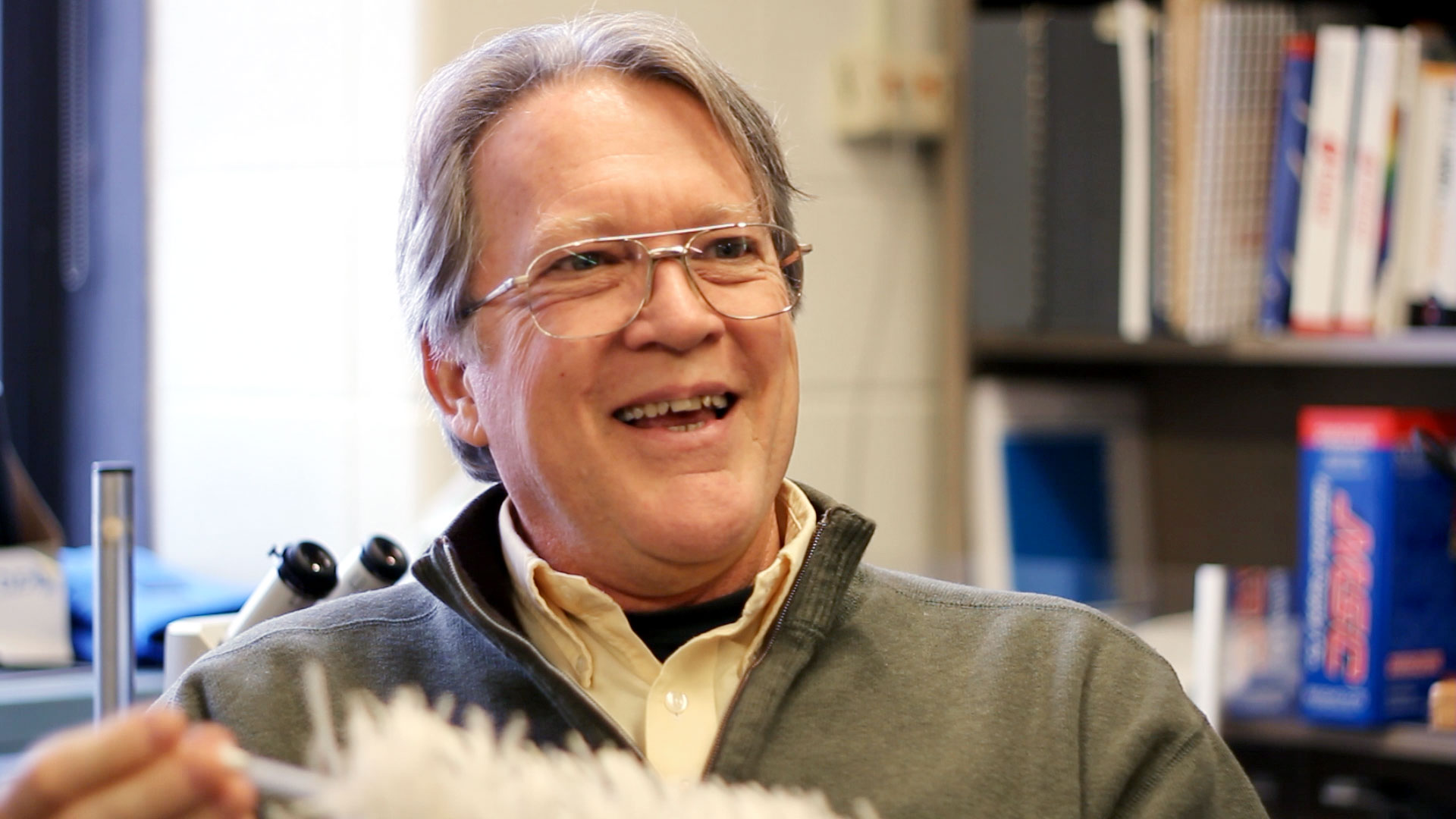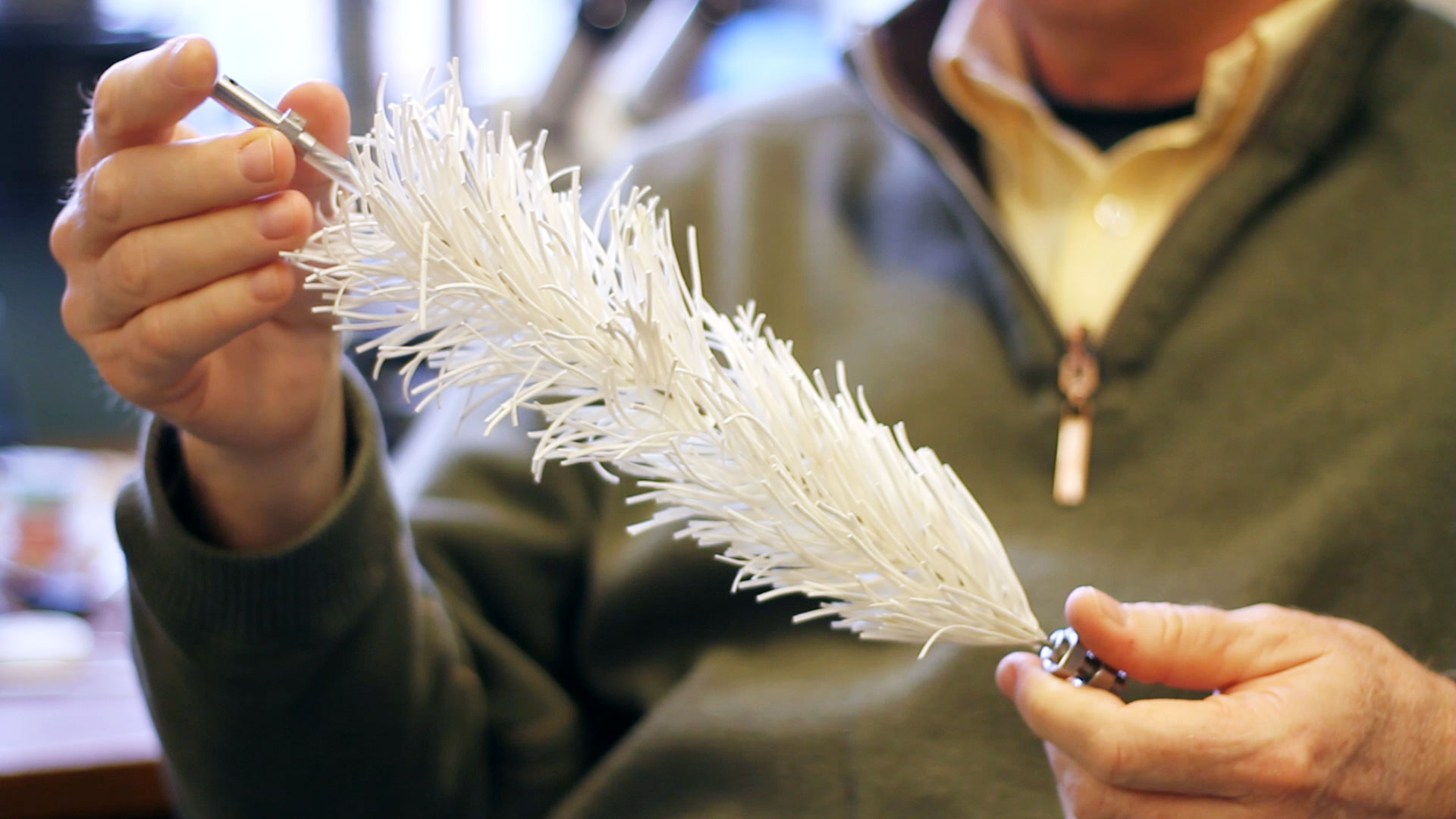Physicist Klaus Lackner has received quite a lot of attention for his artificial “tree” invention that can suck carbon from the air a thousand times faster than real trees. The idea for the tree was originally inspired by his daughter, Claire’s eighth-grade science project that involved extracting carbon dioxide from the air using a fish tank pump and sodium hydroxide. For his invention, Lackner also drew on the natural structure of one of nature’s most successful carbon absorbers – leaves. At Columbia University’s Lenfest Center for Sustainable Energy, where Lackner is director, he and his colleague, Allen Wright, are still finessing elements of the “tree.”
I spoke with Lackner and Allen Wright about the potential of this innovation in helping tackle climate change. An excerpt from our conversation.
 All Photos by Justin StraussKlaus Lackner idea for the carbon-sucking "tree" was originally inspired by his
All Photos by Justin StraussKlaus Lackner idea for the carbon-sucking "tree" was originally inspired by his
daughter’s eighth-grade science project.
Let’s start at the beginning – how do we arrive at a need for air capture technologies like an industrial material that acts as an artificial tree?
Klaus Lackner (KL): Some people argue about how much CO2 are we really allowed to have in the air: should the limit be 450 parts per million? Some people say no, 350 ppm was already too much. Other people are still saying 450 is all right, maybe 550 is all right. And it doesn’t really matter what you think is all right, because once you’ve gotten to that point, the only way to prevent CO2 levels from going higher is to – for all practical purposes – stop putting CO2 in the air.
Why is that?
KL: If you want to stop at 450 ppm, how many tons of CO2 are in the personal CO2 budget of the average person on the planet? It turns out, about 30 tons. Think of a big tanker truck full of gasoline or jet fuel which you may have seen in an airport next to an airplane trying to fill that up – that’s approximately your personal budget. Not for today, not this year, but forever – For you, for your children, and for your children’s children. So every time you go somewhere in a car, you fill it up out of that truck. Every time you fly somewhere you pull it out of that truck. Every time you have Thanksgiving and you have a turkey and turn on the gas stove, you have to take it out of that truck – and it turns out the average person in the US goes through a truck like this in five years. So our budget is gone in five years from now. The world’s budget is gone in about 30 years from now because most people don’t consume as much as we do. Some are a little more careful with it. Some are just too poor to consume it. So at the end of the day you have not much time left to stop.
 Lenfest Center staff scientist Allen Wright says the tree, in essence, functions like
Lenfest Center staff scientist Allen Wright says the tree, in essence, functions like
a CO2 pump that can go on working for years on end.
I know this tree creation isn’t magic, although it nearly seems that way. How did you come up with the concept, how does it work, and how much does it cost to operate?
Allen Wright (AW): The basis is a plastic leaf that has the property of being a vehicle for “air capture.” By air capture, I’m talking about the removal of carbon dioxide from ambient air; from the air outside. If you took all the CO2 out of a block of air roughly the size of a card table, you would just about fill a teacup. Our job is to remove that teacup’s worth of CO2 from any given block of air, concentrate it, and deliver it as a stream of pure CO2. This is different than the removal of CO2 from a concentrated source, such as the exhaust from a power plant or the exhaust pipe on a car.
Consider a situation in which someone is running an old coal power plant somewhere in the world that continues to put CO2 in the air, then what can we do to compensate for the power plant’s emissions? Well, air capture, and this material [holds up artificial pine branch] allows us to take the CO2 out of the air that they have put in.
Does it matter where the CO2 is being emitted? Do you need to set up these trees in the same location?
AW: Actually, one of the reasons we want to remove carbon dioxide from the air is to capture emissions that are occurring in other parts of the world. It turns out that the atmosphere in the world is very well mixed. So if you put CO2 into the air in California, in no time at all that CO2 is very well mixed into the air and you can very effectively take it out of the air in New York City. Now, if you put a ton of CO2 in the air, and you remove a ton of CO2 from the atmosphere somewhere else, you have effectively eliminated the impact of that ton of CO2.
This material has a funny characteristic. In a dry environment (like in the summertime on a hot day, or in the desert), this has a very strong affinity for CO2; CO2 in the air wants to bind with the molecules on the surface of this plastic. In a wet or very humid environment (like it would be here in New York in the summer, or in the tropics), the humidity causes the CO2 to come off of this material and go back into the air.
Well, that’s really neat because that means all the energy we have to use comes from the evaporation of the water off of this as it dries. So, we take this material, which is full of CO2 from being out in the air, and we scrunch it up and put it in a tube, make it wet, and all the CO2 is going to come off of this material and into the gas stream. Then, we can suck that CO2 off and we can deliver it as a stream of carbon dioxide gas. So now we have this material that is wet and empty of CO2, and all we have to do is stick this outside, and if it’s dry outside, the water will evaporate off of this material, and it will revert to the state where CO2 can bind to it again.
And so, in essence, this is a CO2 pump: it takes CO2 from the air and pumps it and delivers it into this stream. This will work over and over for years and years.
How many of the tree samples that you have shown me would be necessary to reduce significantly the amount of CO2 in the atmosphere?
KL: Of those little ones, an awful lot. But you have an awful lot of trees too. So we figured out how to package them for a device which can collect one ton per day and that would fit into a big truck, into a shipping container. Such a unit can collect much more CO2 than your car puts out. You don’t put a ton of CO2 out in a day.
And you would need millions of those one-ton-a-day units, but that’s not so bad if you think about it: If you had ten million such units you would take back 3.6 gigatons of CO2 a year, and right there that’s about 10 or 12 percent of the world’s yearly CO2 output.
That’s a pretty good start.
If the air capture units last ten years, then each year you have to build a million new ones to replace the old ones, creating a production line going of one million units a year. Now the world is producing 70 million cars and trucks a year, so we can do manufacturing on that scale – we do that with automobiles already. So we could make this happen on a scale that is meaningful.
 The invention mimics the natural structure of one of nature’s most successful carbon
The invention mimics the natural structure of one of nature’s most successful carbon
absorbers – leaves
What’s fascinating is that your process and your invention can be seen as a potentially powerful investment if we put a price on it since you can farm and develop many more things from this.
KL: I do want to point out that we are working with a private company, Kilimanjaro Energy.
Would the creation of these air capture devices be a sort of magic pill, making people less inclined to stop the production of CO2 because of it?
KL: It’s a complicated question. Will this tempt you to not deal with the problem? Let me turn this around: What other options do you have?
Furthermore, I think this won’t by itself solve the problem. Scrubbing CO2 from the air is one weapon in the arsenal; by itself it’s not good enough. Clearly there are other places where other strategies are more economical. If you had a power plant and you were to scrub the CO2 out of the power plant that would be much smarter. If you had power which didn’t make CO2 in the first place that would be very useful. But you do end up with some fraction of power that for a long time will emit CO2 because we have that infrastructure, and because it’s actually very difficult to get rid of liquid fuels.
So to come back to your question regarding whether this will encourage people to ignore the problem for a while: The answer is, maybe for some people it does. But the flip side of the problem is: You may not have a choice anymore but to take back CO2. … you need some way of pulling the CO2 out of the air, and forests are not quite fast enough.
How much of a role do people’s choices play in this discussion?
KL: I’m not particularly an advocate for the idea that we have to give up liquid fuels. What I am arguing is that if you successfully remove the problem that liquid fuels create, and you pay for removing that problem, then there’s nothing wrong with using liquid fuels. If you can’t fix the problem or it is too expensive, then you have to find another solution. And in the long run, we cannot let CO2 pile up in the atmosphere. So we have to find answers.
Now, with individual choices it’s always easy to say, ‘I’m such a little bit that it doesn’t matter so I’m ok.’ I’m always amused when I go to a conference and we all talk about how much CO2 everybody emits, and then I proceed to ask a “dumb” question: “how did you all get here?” And the participants all came on long intercontinental airplane trips. When I follow up by asking how much CO2 each participant caused to be emitted on that flight, I am often met with a response to the effect that, since the trip was taken for a good cause, the output in that case doesn’t count. That may well be true, but if we all think that way, we’ll never fix the problem.
So we have two choices: we make it totally expensive to contribute to the problem, such that people opt not to, or we pay for whatever it takes to avoid the problem in the first place. And of course it’s not just one – there are many problems associated with fossil fuel. The first and immediately most important one is that it puts greenhouse gases in the atmosphere. But there are other issues as well. Mining is hazardous and often environmentally difficult business, so you have to figure out how to fix that too. You have work on all of these pieces, but currently the most pressing is CO2.
Do you have any general advice for environmentally-conscious people?
KL: That is a very difficult question. In my opinion, you have to combine realism with optimism because if you can’t do that, you feel like the problems are all so daunting and you’re not coming out of the other side. Realism means that you look at the issues and recognize that there are real problems that require real solutions and then start working on solutions. Don’t start from the premise the world is coming to an end; be an optimist, but be a cautious optimist and make this optimism real.
Maria Ioshpa is a senior at Stuyvesant High School in New York City. Read a longer version of this interview at the City Atlas website.
We don’t have a paywall because, as a nonprofit publication, our mission is to inform, educate and inspire action to protect our living world. Which is why we rely on readers like you for support. If you believe in the work we do, please consider making a tax-deductible year-end donation to our Green Journalism Fund.
Donate